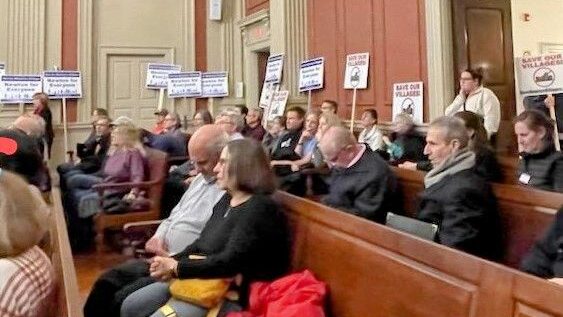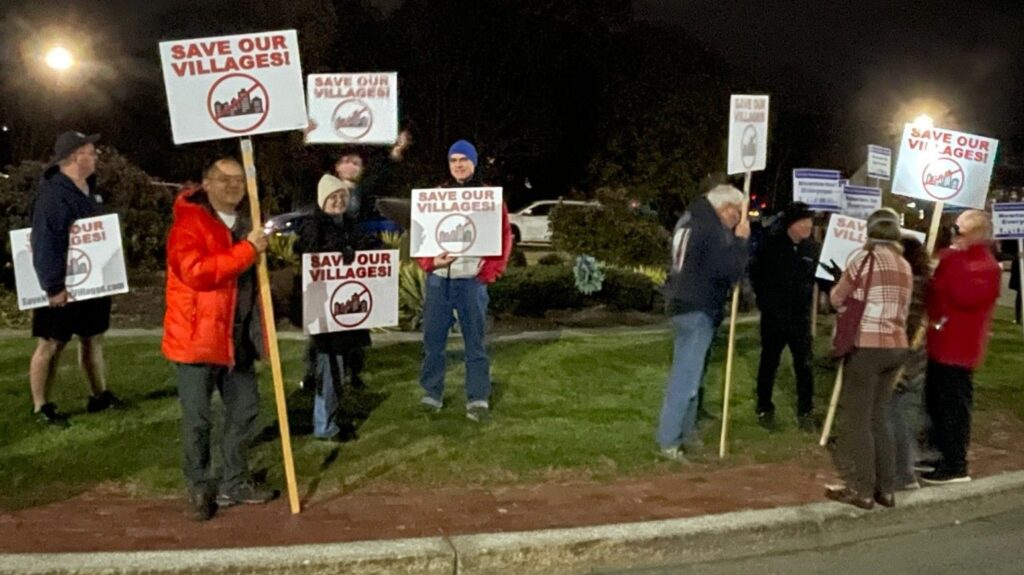CityCouncil
The Newton City Council discusses a plan to rezone the city's village centers. Photo by Joe Hunter
After more than three hours of debate over parking, building size, front and rear setbacks, open space requirements and a whole lot more, Newton’s City Council still didn’t get to a vote on the Village Center Overlay District proposal Wednesday night.
The Council postponed further discussion—and possible vote on the controversial rezoning plan—to Nov. 20.
Here are five highlights from the three-and-a-half-hour zoning discussion:
An awkward start
As the meeting started, Councilor Deb Crossley motioned to allow members of the Law Department and the Planning Department—who were standing in the back of the room—to sit up front with the Council, “inside the rail,” so they could give technical assistance with issues related to planning and the law.
Seven councilors—Leonard Gentile, Tarik Lucas, Julia Malakie, Chirs Markiewicz, John Oliver, and Pam Wright and Lisle Baker—voted against it, effectively telling the Law and Planning people to stay beyond the rail.
At first it was thought such a motion needed three quarters of the Council to approve it, with one councilor still not at the meeting, those six “no” votes had stopped the motion.
“So, um, I don’t know who will run the maps for us when the time comes for the map amendments,” a stunned Council President Susan Albright said. “That will be very awkward, We may have to wait until the next meeting when we can try this again. But we can at least do text amendments tonight, and we will have no guidance from the Planning Department or the Law Department if amendments are made from the floor that we don’t have any guidance on.”
As it turns out—and was discovered in the city’s charter by City Hall staff twenty minutes later—the City Council’s rules only require a simple majority for Crossley’s motion.
So the Law and Planning staff were called back in and seated with the Council, albeit perhaps in awkwardness.
Where things are going
Early in the night, Council President Susan Albright reminded everyone that there was only one item on the docket, the VCOD, and not an alternative plan focusing solely on MBTA Communities Act compliance.
The MBTA Communities Act requires Newton to zone for 8,330 new housing units near its MBTA stops. And Newton has a lot of MBTA stops, spanning several of its villages.
MBTA-served villages, which the city would need to partially upzone comply with the new state law, include Newton Center, Newton Highlands, Newtonville, West Newton and Waban.

Albright then posed three questions to the rest of the Council, in a non-binding hand count.
When asked, “Will you vote for a package that includes all of the MBTA compliant villages?” 18 raised their hands.
When asked, “Will you vote for a package that includes Auburndale?” 13 raised their hands.
When asked, “Do you want a package that includes all the other non-MBTA villages?” only five hands went up.
“So, I think that gives us a sense for where we’re headed tonight and as we discuss this,” Albright said.
Rapid fire from Wright
Councilor Pam Wright offered most of the night’s amendments. She fired one after the other aimed at lessening the scale and impact of the village center rezoning plan.
For example, Wright offered amendments to add a minimum lot size of 6,000 square feet and increase required frontage from 45 feet to 65 feet in proposed MRT lots. MRT lots are those on the edge of village centers, abutting residential neighborhoods. Many MRT lots have multi-family homes on them.
Both of those amendments failed, with only 10 votes in favor.
Wright’s amendment to increase the open space requirement to 50 percent—which would mean only half of the lot could have buildings on it—failed with the same 10 to 14 vote.
Her amendment to require site plan review on all VC2 and VC3 projects 10,000 square feet or larger also failed, with just five councilors voting in favor.
About parking
There was about an hour of discussion about parking. Earlier versions of the Village Center Overlay District plan had no parking requirements. The most recent changes to the plan, however, include a parking requirement for new construction.
Councilor Lisle Baker offered an amendment Monday night to require one parking space for every two units for MRT-zoned lots for adaptive reuse.
Adaptive reuse refers to repurposing an existing property rather than tearing it down and building something new.

“This is reasonable,” Councilor Tarik Lucas said. “I don’t see this being a great obstacle for developers to build housing. It’s just .5 parking spaces per housing unit.”
Councilor Andreae Downs cautioned that parking requirements can sometimes hinder adaptive reuse.
“We have a number of lovely old churches in the city—two of them in Waban I know of for sure—that are going to struggle to fit that [parking] in if they do smaller units and adaptive reuse, which means they would be torn down rather than adaptively reused,” Downs said. “These churches in most of our village centers are within walking distance of services and the T.”
Baker’s amendment passed with 15 in favor and nine against.
Scaling down
Amendments were approved that scale a couple of parcels down from VC3 to VC2 designation.
VC3, which encompasses lots at the heart of the village centers, allows for buildings as tall as 4.5 stories, while VC2—which sits further out from the center—only allows buildings as tall as 3.5 stories.
Crossley cautioned against scaling down zoning in the cores of the villages and said mixed-use buildings often have residential units subsidizing the extra costs that come with building first-floor retail.
“What makes a village? Not just housing,” Crossley said. “We don’t want our villages eventually to become only housing. We want them to be mixed-use. So we need to be mindful of that. And we were mindful of that when we put these maps together.”
The Council adjourned at about 10:30 p.m., but not before Councilor John Oliver got in a post-election jab.
“I think it’s also fair to say that VC3 is probably one of the lightning rods of this entire proposal,” Oliver said. “I think it’s fair to say that, in addition, most of us, myself included, exist in our own echo chamber. We talk to people who talk back to us. We talk to the people who support us and like what we have to say. Not all the time, but most of the time. I’m going to add just one simple fact here, that we just heard a pretty loud echo chamber last week.”
Last Tuesday, three incumbent city councilors—Crossley, Alicia Bowman and Holly Ryan—lost their seats to challengers who ran in opposition to the Village Center Overlay District proposal.
Editor’s note: An earlier version of this story said six councilors voted against allowing Planning and Law staff to sit with the Council. Seven councilors voted “no,” including Lisle Baker, who was off the original count. The story has been updated to reflect the proper number.